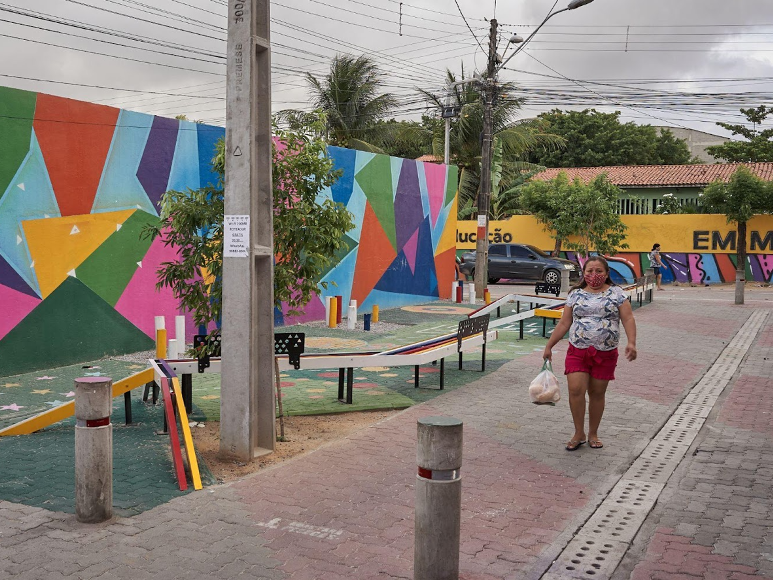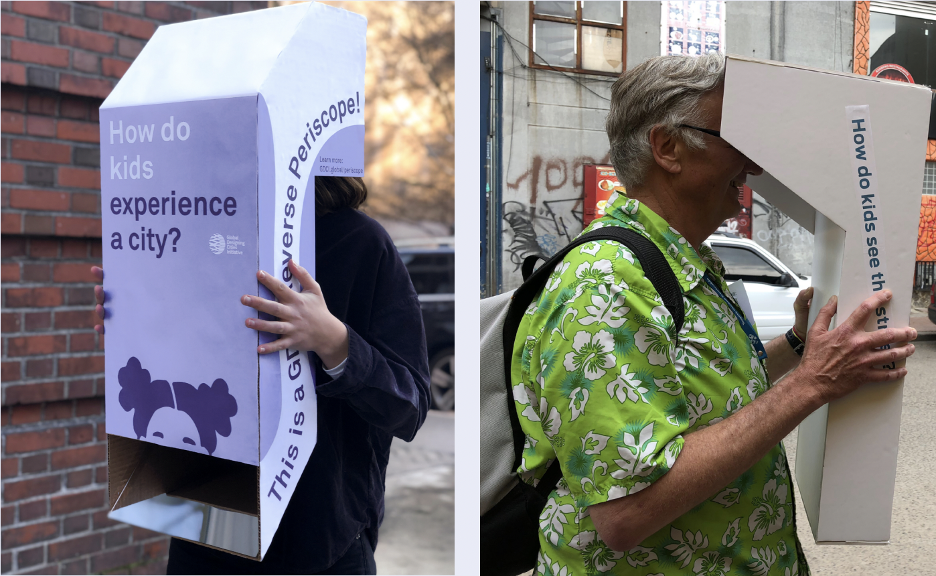
Before the redesign of Rua Antonio Pereira © GDCI

Children and caregivers utilizing the newly redesigned Rua Antonio Pereira © GDCI

Before the redesign of Avenida Chico Mendes © GDCI

Murals, paving and play elements enliven street space for all users © GDCI

Children playing in the reclaimed and redesigned street spaces © GDCI

Playing on redesigned street at night © GDCI
These before and after images show the transformation of grey car-dominated street spaces into colourful and multi-use community spaces. They include attractive and playful benches and interactive elements that encourage kids to create their own games. Murals by a local artist, new landscaping, street lighting and improved drainage repurpose the entire length of the street into a safe and active space for play, walking and other activities during the day and after dark. In addition to these interventions, temporary installations like trampolines set up by community members and shops set up by vendors add to the bustle and liveliness of the street. The redesigned street has improved the quality of life for all street users of all ages. Community members can now walk and cycle on this street much more safely.
Making school journeys safer and reclaiming space for active use through low-cost interventions
Another highly successful Streets for Kids Technical Assistance project started in 2020 was My Way to School in Santiago, Chile. GDCI partnered with Ciudad Emergente – a Chilean nonprofit focused on implementing walkability, safe cycling facilities, and road safety projects – and selected Enrique Soro Street as the project site. The project’s main objectives were establishing safe intersections, extending sidewalks, and reducing speeds.
The team divided the project into two stages. The first stage was the “My Way To School” kit, a take-home engagement tool crafted by Ciudad Emergente for students at Juana Atala de Hirmas school in Renca. The second stage was implementing a pilot project on Enrique Soro Street in Independencia. This street is part of the daily route for many children who attend Juana Atala de Hirmas school.
The “My Way To School” Kit enabled Ciudad Emergente to collect key data regarding children’s perceptions of their journey to school. Speeding cars and the fear of getting run over were prevalent themes.With this in mind, the objective of the pilot intervention was to improve road safety through chicanes, add new pedestrian crossings, improve pedestrian space and make the street more attractive by adding elements of colour and games.
The Streets for Kids pilot project was implemented in November 2021. The implementation involved over 80 people in data collection and the painting, installation, and activation of the space. The implementation budget was close to USD 20,000, half for materials and implementation and another half for community engagement activities and site activation through various events.
‘The objective of the intervention was to improve road safety’
During the pilot phase, the project team surveyed children, caregivers, and community members who lived near Enrique Soro Street. The surveys found that over 400 children and caregivers participated in the activation of Enrique Soro Street; 85 per cent of children and caregivers not only consider it safe to cross the street following implementation but also consider it exciting and joyful to walk around Enrique Soro Street. Project outcomes included 1,500 square meters of reclaimed pedestrian space, six newly marked pedestrian crossings, 2,000 square meters of space for children and caregivers to enjoy, and 60 per cent fewer speeding vehicles.
After the project implementation, Ciudad Emergente and GDCI hosted an online training for over 40 municipal leaders from Santiago, sharing the project’s success and explaining the implementation and community engagement process. Ciudad Emergente received over ten requests to help bring similar initiatives to other municipalities in Santiago. The most significant barrier to scaling up this program is the lack of funding and stretched staff capacity after the Covid-19 pandemic.
Guides, training and tools for creating streets for children
One of our most popular resources is the Designing Streets for Kids —a publication composed of best practices, strategies, programs, and policies used by cities worldwide to design spaces suitable for children of all ages. The guide shares design recommendations and case studies highlighting safe, enjoyable, and inspirational streets for children and their caregivers. Designing Streets for Kids expands on the principles first outlined in GDCI’s Global Street Design Guide, our landmark guide, which offers technical details to inform street design that prioritizes pedestrians, cyclists, and transit riders in cities around the world.
Since the launch of Designing Streets for Kids, GDCI’s Streets for Kids team has had the opportunity to partner more closely with cities around the world to bring these strategies and concepts to life. From 2019 to 2021, we enabled child-focused strategies in 12 cities through streetscape transformations, workshops, and trainings, including Fortaleza, Brazil; Kigali, Rwanda; Santiago, Chile; Tirana, Albania; Cape Town, South Africa; Colima, Mexico; Kazan, Russia; Lima, Peru; Pasig City (Metro Manila), Philippines; Tbilisi, Georgia; Tulsa, Oklahoma, USA; and Udaipur, India.
In 2022 we convened an inaugural Streets for Kids Leadership Accelerator, which brought together 60 changemakers from 20 cities worldwide to participate in an eight-month virtual professional leadership program. The program also included the start of several self-paced online training courses open to industry practitioners.
Earlier in 2023, we published How Do Kids Experience Streets? The Reverse Periscope Companion Guide, This simple how-to guide explains how to create a Streets for Kids Reverse Periscope, a DIY tool that can help everyone experience streets from a child’s perspective. We hosted a webinar about the tool in early March with partners in Lima, Peru, and Bogotá, Colombia. We hope everyone everywhere considers holding a Reverse Periscope “walkshop” in your community. Later in 2023, we will focus on helping 10 Leadership Accelerator participant cities move forward with their Streets for Kids work through select implementation grants. We also anticipate releasing new technical supplements that will further explore topics from the Designing Streets for Kids guide.

Adults using GDCI’s Reverse Periscope © GDCI
To stay updated on GDCI’s Streets for Kids work — including new resources, events, and opportunities – join our email list and visit our website to learn more about what we do and stay connected! We look forward to learning more about your work creating #StreetsForKids.
The Bernard Van Leer Foundation, the FIA Foundation, and Fondation Botnar generously support the Streets for Kids program
This blog was first published by the Global Alliance – Cities4Children (www.cities4children.org/blog)’
Anna Siprikova is the Senior Program Manager for the Global Designing Cities Initiative, where she leads the Streets for Kids program. Anna is a co-author of the award-winning Designing Streets for Kids guide. She is an urban planner by day, a mother by night, and a tireless streets for kids advocate.












